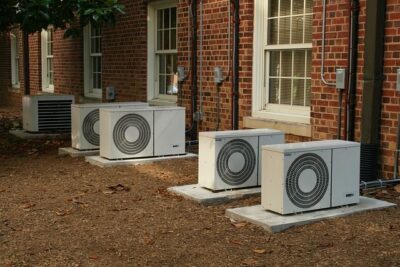To maximize comfort and reduce energy consumption, you must choose a heating and cooling solution that suits your house and the climate conditions of your location the best.
And countless old and newly emerging HVAC systems make it difficult for homeowners like you to find the right heating and cooling unit.
However, there’s no need to worry. We have got you covered.
Here are the top three heating and cooling options you should look out for when choosing an HVAC system for your home.
Heating and Air Conditioning Split System
A heating and air conditioning split system usually has two separate units. An outdoor unit, which is either a heat pump or an air conditioner. Plus, an indoor unit, which usually consists of an air handler or a furnace.
This split system uses the outdoor unit to cool the air and then transfers the cold air to the indoor unit, which circulates it throughout your home using ducts.
What’s more, during the cold weather conditions, the furnace system activates instead of the air conditioning unit to keep your house warm and cozy.
If your home already has ductwork, this split HVAC system is a perfect match for you. However, if your house is larger than usual, then this HVAC system may prove to be inefficient due to heat loss in the ducts.
The extreme weather conditions may also reduce the efficiency of this heating and cooling split system.
Because of these reasons, this system will only work if your house isn’t too big or if the difference in temperature during the hotter and colder months isn’t too extreme.
It’s best to consult reliable HVAC and plumbing services and see if the split system will work for you.
Packaged Heating and Cooling Units
Unlike the split systems, packaged HVAC systems fit the heating and cooling system inside a single unit, which the installers usually place outside of your home.
This system delivers warm or cold air through your house’s ductwork, making it a perfect match for homes that lack attics, basements, or enough indoor space.
Installing this packaged HVAC system is also a simple job. To do that, your installers just have to:
- Place the system in a secure place outside of your home or on your rooftop.
- Connect the unit with the required ductwork.
- Attack all the necessary wires and gas lines.
Once it’s done, these units will supply your home with necessary heating and cooling while saving electricity, depending on the weather conditions.
The Heat Pump System
This system is made of an outdoor unit, which is a heat pump, and an indoor air handler.
The way this HVAC system works is pretty straightforward. During the colder months, the heat pump system will transfer heat from outdoors to indoors to keep your home warm. And during the warmer months, it does the exact opposite to keep your home cooler.
However, you need to remember that this HVAC system works especially well in places with a moderate climate. As long as extreme cold is less common in your area of residence, the heat pump system can keep your home warm efficiently.
What’s more, the heat pump systems are usually up to 50% more efficient compared to furnaces, boilers, and other traditional HVAC units.
It not only decreases energy consumption and energy costs, but it also provides you with a sustainable, eco-friendly heating and cooling option.
Needless to say, the heat pump system is a perfect choice for those who want to minimize their carbon footprint while saving a significant portion of energy.
Final Thoughts!
Choosing the right HVAC system depends on multiple factors, including but not limited to energy efficiency, climate, the size of the home, and the budget.
You must evaluate your specific needs carefully before making a choice between any of the three HVAC units we have mentioned above.
Still in dilemma?
Don’t worry. You can always consult an experienced HVAC and plumbing service or specialist, who will help you make the right decision.
View the original article and our Inspiration here


Leave a Reply